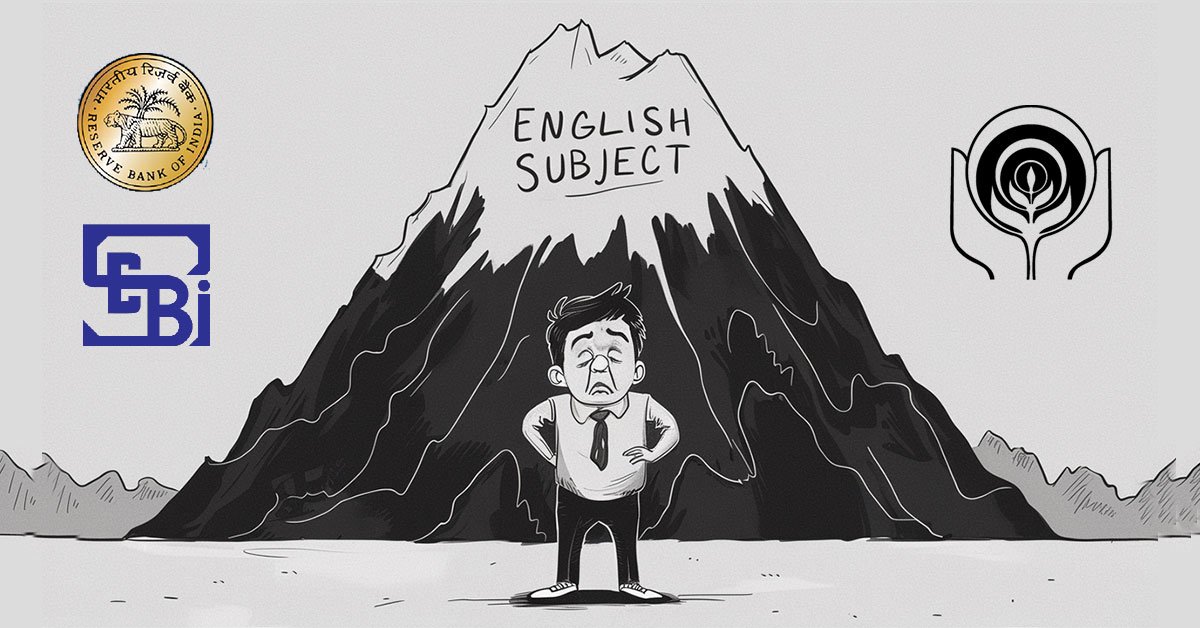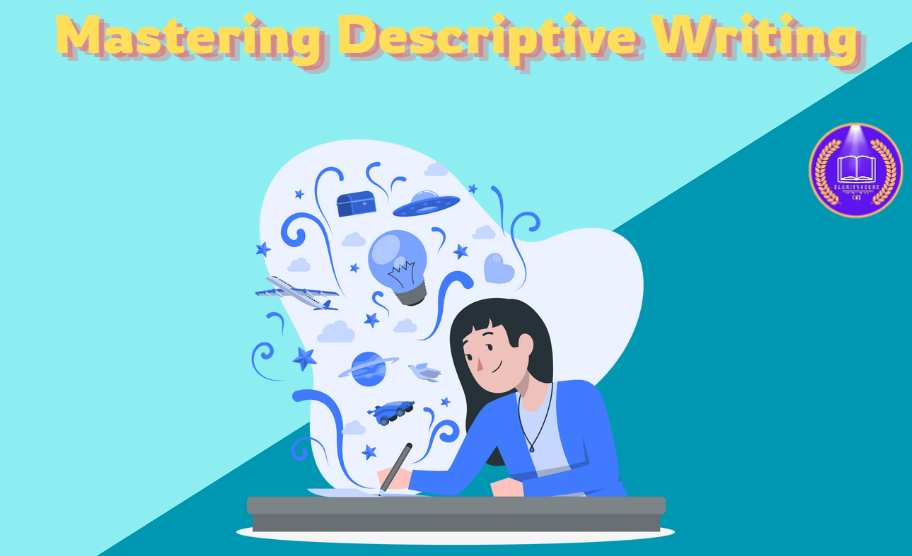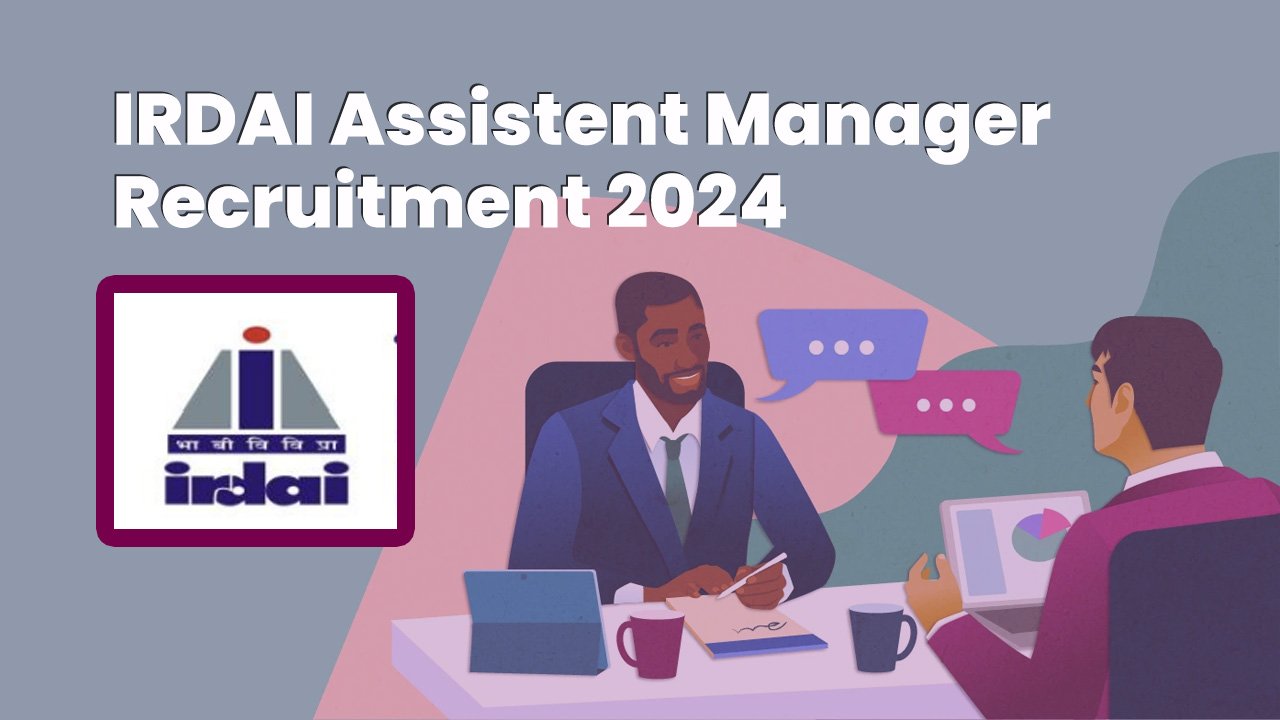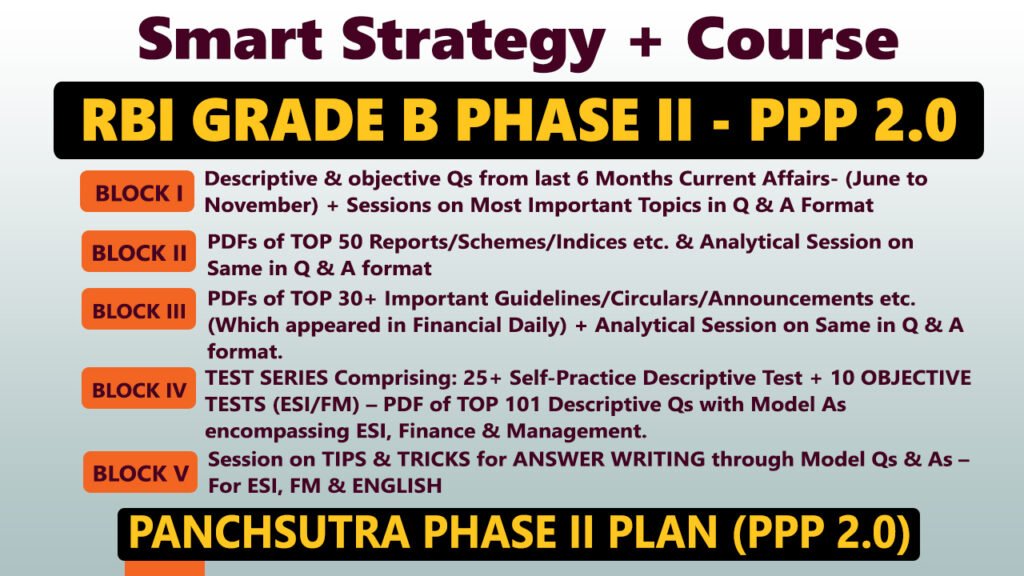IRDAI Phase II Mains English Descriptive Previous Year Questions and Model Answer 2024
| Section | Word Limit | Marks | Details |
|---|---|---|---|
| Essay | 500 words | 30 | Topics: |
| 1. Strategies for Insurance for all by 2047 in India | |||
| 2. Pros and Cons of Artificial Intelligence | |||
| 3. The power of positive thinking | |||
| Precis | 150 words | 15 | Summarize the given passage concisely while retaining its core meaning. 1. Women participation in the labor force and women empowerment |
| Letter | 200 words | 20 | – Formal: Write to the commissioner about the dog menace in your society. |
| – Informal: Write to your nephew regarding the spread of fake news on social media. | |||
| Expansion | 100 words | 15 | Expand on the given statement: |
| 1. Scope of CSR in India | |||
| 2. Ethical leadership | |||
| Reading Comprehension | 4 questions (70-80 words each) | 20 | Topics: |
| 1. Data Analytics in Insurance |
Model Answer, Word limit, Pattern and Previous Year cutoff for IRDAI Phase II English descriptive question
01. Pattern of Exam
| Exam | Mode | Paper | Type of Paper | No. of Questions | Duration |
|---|---|---|---|---|---|
| Paper 1 | Pen and Paper mode/Hybrid | General English (33.33%) | Descriptive | 5 | 60 minutes |
NOTE: Descriptive questions will be displayed on screen of your computer. Answers are to be written on separate answer sheets which will be provided at the exam venue.
02. Word Limit for IRDAI English descriptive paper phase II
| Section | Word Limit | Marks | Details |
|---|---|---|---|
| Essay | 500 words | 30 marks | Write a detailed essay on the given topic. |
| Precis | 150 words | 15 marks | Summarize the passage concisely, retaining its essence. |
| Letter | 200 words | 20 marks | Formal or informal letter based on the given prompt. |
| Reading Comprehension | 4 questions | 20 marks (5 each) | Answer questions based on the provided passage. |
| Expansion Statement | 100 words | 15 marks | Expand on the given statement, providing clarity and depth. |
03. Stream Wise IRDAI Assistant Manager Cut Off 2023 of IRDAI English descriptive paper phase II
| Category | Prelims Total Marks | Prelims Cut Off (%) | Mains Total Marks | Mains Cut Off (%) | Interview Combined Marks (out of 100) |
|---|---|---|---|---|---|
| General/UR | 87.25 | 25% | 183 | 61% | 74.12 |
| EWS | 63.75 | 25% | 168 | 56% | 64.37 |
| OBC | 80.75 | 25% | 171 | 57% | 67.89 |
| SC | 70.25 | 25% | 157 | 52.33% | 66.58 |
| ST | 47.75 | 23.75% | 150 | 50% | 65.35 |
| PwBD | 39.50 | 13.75% | 146 | 48.67% | 63.11 |
Note: The IRDAI Assistant Manager Cut Off marks 2024 are decided by the IRDAI. These marks are different for candidates belonging to different categories, and are based on various factors like number of vacancies, number of applicants, highest scores obtained, last year cut off and the difficulty of the paper.
04. Model Answers
The length of model answers is more with a greater number of points which will help you to have better idea for the topic and write accordingly as per your need
- Strategies for Insurance for all by 2047 in India
- Pros and Cons of Artificial Intelligence
- The power of positive thinking
IRDAI Phase II Mains English Descriptive question 2024
1. Strategies for Insurance for all by 2047 in India
Introduction
Insurance serves as a critical safety net, fostering economic stability and resilience against risks such as health emergencies, natural disasters, and financial insecurities. Ensuring “Insurance for All” by 2047 is a significant goal for any nation, particularly one like India, where a substantial portion of the population remains uninsured or underinsured. To achieve this ambitious target, multi-pronged strategies, innovative policies, and robust implementation frameworks are required.
Insurance Regulatory and Development Authority of India (IRDAI) has committed to enable ‘Insurance for All’ by 2047, where every citizen has an appropriate life, health and property insurance cover and every enterprise is supported by appropriate insurance solutions and also to make Indian insurance sector globally attractive.
To attain this objective, efforts are being made towards creating a progressive, supportive, facilitative and a forward-looking regulatory architecture to foster a conducive and competitive environment leading to wider choice, accessibility and affordability to policyholders. This reform agenda taken up by IRDAI derives inspiration from the Government of India’s vision of financial inclusion and strong emphasis on accelerating reforms.
The focus of IRDAI is to strengthen the three pillars of the entire insurance ecosystem viz. insurance customers (policyholders), insurance providers (insurers) and insurance distributers (intermediaries) by
- making available right products to right customers
- creating robust grievance redressal mechanism
- facilitating ease of doing business in the insurance sector
- ensuring the regulatory architecture is aligned with the market dynamics
- boosting innovation, competition and distribution efficiencies while mainstreaming technology and moving towards principle based regulatory regime
Strategies
- Expanding Insurance Penetration
Insurance penetration, measured as the percentage of GDP spent on premiums, stood at 4.2% in India in 2021, compared to the global average of 7.3%. Increasing this figure requires targeted measures:- Microinsurance Models: Low-cost insurance products tailored for rural and economically weaker populations.
- Technology-Driven Distribution: Use of mobile apps, digital wallets, and telematics to improve access.
- Collaborations with Local Institutions: Partnering with self-help groups (SHGs), cooperative banks, and microfinance institutions for better outreach.
- Universal Health Coverage (UHC)
India’s health insurance penetration was about 37% in 2022, leaving a significant gap in coverage.- Ayushman Bharat Scheme Expansion: Scaling up government initiatives like the Ayushman Bharat Pradhan Mantri Jan Arogya Yojana (AB-PMJAY), which provides free health insurance to 500 million people.
- Public-Private Partnerships (PPP): Engaging private insurers to supplement public health schemes.
- Awareness Campaigns: Educating citizens about the benefits of health insurance, particularly in rural areas.
- Leveraging Digital Transformation
Digital technologies can revolutionize insurance access and efficiency.- AI and Big Data Analytics: Predictive analytics can customize products and detect fraudulent claims.
- Blockchain: Ensures transparency and security in insurance transactions.
- Digital Identification: Leveraging Aadhaar-linked policies for seamless onboarding.
- Agriculture Insurance for Farmers
Over 50% of India’s population depends on agriculture, yet crop insurance penetration remains low.- Pradhan Mantri Fasal Bima Yojana (PMFBY): Strengthening and streamlining this scheme to cover all farmers by 2047.
- Weather-Based Insurance: Using satellite data and weather forecasting for accurate risk assessment.
- Subsidized Premiums: Providing affordable insurance options to small and marginal farmers.
- Addressing Urban Insurance Needs
Urban populations face risks like property loss, cybercrime, and health emergencies.- Home Insurance Awareness: Promoting home insurance for protection against natural disasters and accidents.
- Cybersecurity Insurance: Encouraging policies to mitigate risks from increasing cyber threats.
- Health Insurance for the Middle Class: Affordable policies catering to urban working professionals.
- Financial Inclusion and Literacy
As of 2022, 22% of the Indian population was financially illiterate. Addressing this gap is crucial for increasing insurance uptake.- Insurance Literacy Campaigns: Educating citizens about the importance of life, health, and asset insurance.
- Bank-Linked Insurance Products: Promoting schemes like Pradhan Mantri Jeevan Jyoti Bima Yojana (PMJJBY) and Pradhan Mantri Suraksha Bima Yojana (PMSBY).
- Incentivized Savings Schemes: Linking savings accounts with bundled insurance benefits.
- Strengthening the Regulatory Framework
The Insurance Regulatory and Development Authority of India (IRDAI) plays a pivotal role in driving reforms.- Simplified Policies: Standardizing policy terms to reduce complexity.
- InsurTech Regulation: Encouraging innovation while ensuring consumer protection.
- Mandatory Insurance Policies: Introducing mandates for critical areas like disaster insurance and third-party liability.
- Climate Risk Insurance
With India witnessing an increase in climate-related disasters, climate risk insurance is essential.- Disaster Risk Financing: Developing government-backed funds for disaster-prone areas.
- Community-Based Insurance: Engaging local communities in risk-sharing mechanisms.
- Global Collaboration: Partnering with international organizations for technical and financial support.
- Monitoring and Evaluation
Regular assessments are vital to measure progress and address gaps.- Performance Indicators: Setting benchmarks for insurance coverage, claim settlements, and customer satisfaction.
- Feedback Mechanisms: Ensuring citizen participation in policy improvements.
- Periodic Reviews: Publishing reports on the state of insurance penetration and future action plans.
Conclusion
Achieving “Insurance for All” by 2047 requires a holistic approach involving government, private players, and citizens. As per IRDAI, achieving 100% insurance penetration could add 1.5% to India’s GDP annually, fostering economic stability and resilience. By leveraging technology, increasing financial literacy, and expanding access to affordable insurance products, this vision can become a reality. Empowering every individual with insurance coverage will not only secure their future but also strengthen the nation’s socio-economic fabric.
2. Pros and Cons of Artificial Intelligence
Introduction
Artificial Intelligence (AI) refers to the simulation of human intelligence in machines programmed to think, learn, and perform tasks autonomously. By leveraging algorithms, data, and computing power, AI powers innovations like chatbots, self-driving cars, and predictive analytics, transforming industries and enabling smarter decision-making across various fields. While AI offers immense potential to drive growth and innovation, it also brings challenges that need careful consideration.
The term “father of AI” is often attributed to John McCarthy, an American computer scientist who coined the term “artificial intelligence” and made significant contributions to the field’s early development.
The term “Artificial Intelligence” was coined in 1956 at the Dartmouth Conference, marking the formal birth of AI as a field. Early AI focused on problem-solving and logic-based systems, with programs like ELIZA, an early chatbot, gaining attention in the 1960s.
Artificial Intelligence has vast applications across diverse fields, revolutionizing how tasks are performed and decisions are made. Key applications include healthcare, finance, transportation, retail and e commerce, education, manufacturing, entertainment, customer service, agriculture and security.
Pros of AI
Artificial Intelligence offers numerous advantages that enhance efficiency, productivity, and innovation across various fields. AI’s potential to streamline operations and enable smarter solutions continues to transform industries and improve everyday life.
- Enhanced Efficiency and Productivity
AI automates repetitive and time-consuming tasks, enabling businesses to optimize operations.
Example: A McKinsey study in 2022 estimated that AI could contribute $13 trillion to the global economy by 2030 by improving efficiency in industries like manufacturing, logistics, and healthcare. - Improved Decision-Making
AI-driven analytics provide insights for better decision-making.
Example: In healthcare, AI algorithms can analyze medical records and imaging, improving early detection of diseases like cancer with over 90% accuracy. - Economic Growth and Job Creation
AI is creating new job opportunities in fields like data science, machine learning, and robotics.
The World Economic Forum’s “Future of Jobs Report 2023” predicts that AI will create 97 million new roles globally by 2025. - Personalized Services
AI enables personalized customer experiences in e-commerce, education, and entertainment.
Example: AI-powered recommendation systems used by platforms like Netflix and Amazon drive user engagement and sales. - Advancements in Healthcare
AI supports precision medicine, drug discovery, and robotic surgeries.
Example: During the COVID-19 pandemic, AI models were used to predict outbreaks and accelerate vaccine development. - Sustainability and Climate Change Mitigation
AI helps monitor and reduce carbon footprints through smart grids, energy-efficient systems, and predictive maintenance.
Example: AI-based tools like Google’s DeepMind reduced energy usage in data centres by 40%.
Cons of AI
While Artificial Intelligence offers numerous benefits, it also presents significant challenges and risks. Key disadvantages include:
- Job Displacement
While AI creates new roles, it also automates existing jobs, leading to unemployment in traditional sectors. According to the International Labour Organization (ILO), AI and automation could displace 14% of jobs worldwide by 2030. - Ethical Concerns
AI algorithms can reinforce biases if trained on biased data, leading to discriminatory outcomes.
Some AI-powered hiring tools have been found to favor certain demographics, highlighting fairness issues. - High Implementation Costs
Developing and maintaining AI systems requires significant financial and technical resources.
Small businesses often struggle to adopt AI due to costs, with 75% citing lack of funding as a barrier, according to a Gartner report (2023). - Data Privacy and Security Risks
AI systems depend on large datasets, raising concerns about data misuse and breaches.
AI-driven facial recognition technologies have faced criticism for invading privacy and misuse in surveillance. - Lack of Accountability
AI systems can make errors or take decisions that are hard to explain or challenge.
Example: Autonomous vehicles have been involved in accidents, raising questions about liability and accountability. - Potential Weaponization
AI can be used for malicious purposes, such as creating autonomous weapons or deepfake content.
The European Commission’s 2023 report highlighted that cyberattacks using AI have increased by 300% over the past five years.
Government Initiatives to Address AI’s Impact
- National AI Strategy (NITI Aayog)
Focuses on AI for societal benefit in areas like agriculture, healthcare, and education.
Establishes India as a global AI leader by promoting research, skill development, and ethical AI. - Digital India Programme
Encourages AI adoption to improve governance, citizen services, and infrastructure. - Responsible AI for Youth (RAIY)
Aims to train young Indians in AI skills and promote innovation among students. - AI in Governance
AI-powered tools like the “MyGov Corona Helpdesk” were used during the pandemic to provide real-time information to citizens.
Conclusion
AI is a double-edged sword, offering transformative benefits while presenting significant challenges. With the right policies, ethical practices, and global collaboration, its potential can be maximized to benefit society. By fostering innovation and ensuring inclusivity, nations like India can use AI as a tool for sustainable growth, contributing to a more equitable and prosperous future.
3. The power of positive thinking
“None can destroy iron, but its own rust can! Likewise, none can destroy a person, but his own mindset can”, says Ratan Tata.
Positive thinking is a mental and emotional attitude that focuses on the bright side of life and expects positive results. You are what you think, you become what you think, and thoughts influence your life. Positive thinking casts a magical influence on everyone and has immeasurable potential such as the power to shake the mountains, break the glass ceilings and reach greater heights.
According to Daisaku Ikeda, “When your determination changes, everything else will begin to move in the direction you desire. The moment you resolve to be victorious, every nerve and fiber in your being will immediately orient itself towards your success
Suresh Lalan of Surat who was afflicted by polio is now the CEO of Sparkle Diamond with 600 artisans working under him. Ira Singhal became the first physically challenged woman to top the UPSC Civil Services Exam. Beno Zephier is the 1st blind IFS officer. They all have overcome all obstacles through their positive attitude, courage and conviction.
Benefits of Positive Thinking
- Improved Mental Health
Positive thinking reduces stress, anxiety, and depression by focusing on hope and solutions instead of dwelling on problems. According to a study published in the Journal of Personality and Social Psychology, individuals with an optimistic mindset are 30% less likely to develop depression than pessimistic individuals.
Example: During the COVID-19 pandemic, many people used positive affirmations and mindfulness practices to maintain mental stability, helping them cope with isolation and uncertainty. - Better Physical Health
Optimistic people tend to have stronger immune systems, lower blood pressure, and reduced risk of chronic diseases. A 2019 study in the Proceedings of the National Academy of Sciences found that people with a positive outlook live, on average, 11-15% longer and are more likely to reach the age of 85 or beyond.
Example: Cancer survivors often credit a positive attitude, alongside medical treatment, for boosting their recovery and quality of life. - Enhanced Resilience
Positive thinkers are better at overcoming setbacks and adapting to change. They perceive challenges as opportunities for growth rather than obstacles. A study by the American Psychological Association found that resilience is strongly linked to optimism, with resilient people recovering faster from trauma or stress.
Example: Nelson Mandela, who spent 27 years in prison, maintained a positive outlook, believing in the possibility of ending apartheid, which eventually led to his leadership in a free South Africa. - Improved Relationships
Positive thinking promotes trust, empathy, and effective communication, enhancing personal and professional relationships.
Example: Oprah Winfrey, a global icon, attributes much of her success to maintaining optimism and spreading positivity, which helped her build a vast network of meaningful connections. - Career Success
Positive thinkers are more creative, productive, and better problem-solvers, leading to professional growth and success. A study found that employees with a positive outlook are 31% more productive and three times more engaged in their work.
Example: Elon Musk’s positive thinking and vision for the future enabled him to overcome failures with Tesla and SpaceX, ultimately revolutionizing the automotive and space industries.
Mechanisms of Positive Thinking
- Reframing Negative Thoughts
Positive thinking helps individuals turn negative thoughts into constructive ones.
Thomas Edison’s response to multiple failures while inventing the light bulb reflects reframing: “I have not failed. I’ve just found 10,000 ways that won’t work.” - Gratitude Practice
Expressing gratitude shifts focus from what is lacking to what is present, fostering a sense of abundance and happiness and people who practice gratitude regularly experience a 23% reduction in cortisol levels (the stress hormone). - Visualization and Affirmations
Visualization and affirmations help individuals imagine success and stay motivated.
Athletes like Michael Phelps use visualization techniques to prepare mentally for competitions, contributing to their success. - Surrounding Yourself with Positivity
Being around positive people and environments fosters optimism and happiness is contagious and spreads through social networks, increasing overall positivity.
Challenges of Positive Thinking
- Toxic Positivity
Overemphasizing positivity may lead to ignoring or suppressing real emotions, which can hinder emotional growth. Telling someone to “just stay positive” during grief can invalidate their feelings and prevent healthy coping. - Unrealistic Expectations
Blind optimism can lead to disappointment if it is not backed by practical efforts.
Believing that success will come without hard work can result in failed ventures, as seen in many startup failures. - Maintaining Positivity During Adversity
It can be difficult to remain optimistic during significant setbacks or crises.
Example: Survivors of natural disasters, such as hurricanes or earthquakes, often struggle to rebuild their lives despite attempts to maintain a positive outlook.
Government Initiatives to promote positive thinking
- Mental Health Programs: Governments worldwide are promoting mental health awareness and positivity. The Ministry of Health and Family Welfare launched the MANAS app in 2021, aimed at promoting mental well-being and resilience.
- Educational Campaigns: Schools are integrating positive psychology and life skills training. In fact, Finland’s education system emphasizes emotional intelligence and positive thinking from an early age.
- Community Initiatives: Governments encourage activities like yoga, meditation, and mindfulness.
Example: India’s International Day of Yoga, celebrated globally, promotes mental and physical positivity.
Employee Wellness Programs: Companies like Google and Microsoft offer mindfulness and resilience training to enhance workplace positivity.
Leadership Models: Positive leadership strategies, like Servant Leadership, focus on empathy and optimism to inspire teams.
Conclusion
Positive thinking is a transformative mindset with far-reaching benefits for individuals and society. It enhances mental and physical health, strengthens relationships, fosters resilience, and drives success. While challenges like toxic positivity and unrealistic expectations exist, they can be mitigated with awareness and balance. By adopting gratitude, visualization, and reframing techniques, individuals can harness the true power of positive thinking. As governments, organizations, and individuals promote optimism and mental well-being, a brighter, more resilient future becomes possible.
Precis
Questions asked in IRDAI PHASE -2 English descriptive online exam
- Paragraph based on Women participation in Labour force and Women Empowerment
Exact paragraph
To be updated soon
Letter questions asked in IRDAI PHASE -2 English descriptive exam
Model Answer
1. Formal LETTER
Write a letter to commissioner regarding dog menace in your societ
[Your Name]
Your Address,
City,
State-PIN Code
[Date]
The Commissioner
Municipal Corporation Name
City
State
Subject: Addressing the Issue of Stray Dog Menace in Our Society
Dear Sir/Madam,
I am writing to bring to your attention the growing problem of stray dog menace in [Society/Area Name], which has become a serious concern for the residents. Over the past few months, the number of stray dogs in our area has increased significantly, leading to various challenges for the community.
The main issues we are facing include:
- Aggressive Behaviour: Several incidents of dogs chasing and biting pedestrians, particularly children and elderly residents, have been reported.
- Noise Pollution: Constant barking during the night has disrupted the peace and caused inconvenience to residents.
- Sanitation Problems: Stray dogs often scatter garbage around, which not only looks unsightly but also raises hygiene concerns.
- Public Safety: Some dogs appear to be sick or injured, posing potential risks of disease transmission.
While we understand the importance of treating animals humanely, it is equally essential to ensure the safety and well-being of the residents. We request the municipal authorities to take immediate and appropriate measures to address this issue.
Possible actions could include:
Conducting sterilization and vaccination drives for stray dogs.
Setting up proper shelters for stray animals.
Increasing garbage disposal efficiency to avoid attracting strays.
We kindly request your intervention in this matter at the earliest, as it is directly impacting the quality of life in our society. We are hopeful that the municipal corporation will take swift and effective steps to resolve this issue.
Thank you for your attention and assistance.
Yours sincerely,
Your Full Name
Sign
2.Informal Letter
Write a letter to your nephew regarding rampant spread of fake news on social media
[Your Name}
Your Address
City,
State-PIN Code
[Date]
Dear [Nephew’s Name],
I hope this letter finds you in good health and high spirits. I wanted to take a moment to share something important, considering how much time we all spend on social media these days.
You must have noticed the growing issue of fake news spreading rapidly online like a wildfire. It’s a serious concern in today’s world, as misinformation can cause panic, misunderstandings, and even harm people’s lives. Social media is a powerful tool, but with it comes the responsibility of using it wisely.
Fake news often appears credible, with sensational headlines designed to grab attention. Many times, people share such posts without verifying their authenticity, leading to widespread confusion. It’s crucial to always fact-check information before sharing it. Reputable and genuine news sources and fact-checking websites can help determine the actual truth behind a story.
As someone who’s tech-savvy and active online, you can play a significant role in curbing this menace. Here are a few tips:
- Think Before Sharing: Ask yourself if the information comes from a reliable source.
- Verify Facts: Cross-check with trusted news outlets or official websites.
- Avoid Emotional Traps: Fake news often uses sensational language to provoke strong emotions.
- Educate Others: Politely inform friends and family when they share incorrect information.
Remember, being responsible on social media helps build a more informed and aware society. I trust you’ll take this issue seriously and encourage others around you to do the same.
Looking forward to hearing your thoughts on this. Take care and keep growing into the thoughtful and aware individual.
With love,
[Your Name]
Expansion Statement asked in IRDAI PHASE -2 English
Model Answer
1. Scope of CSR in India
The scope of Corporate Social Responsibility (CSR) in India is vast, focusing on sustainable development and societal welfare. With the Companies Act, 2013 mandating CSR for certain companies, initiatives now span diverse areas such as education, healthcare, rural development, environmental sustainability, women empowerment, and skill development. Companies actively engage in community development projects, disaster relief, and preservation of arts and culture. CSR also aligns with global goals like the UN Sustainable Development Goals (SDGs), addressing poverty, inequality, and climate change. By integrating social, economic, and environmental objectives, CSR in India aims to foster inclusive growth and holistic societal progress.
2. Ethical leadership
Ethical leadership involves guiding individuals or organizations with integrity, fairness, and respect for ethical and moral principles. It focuses on leading by example, promoting transparency, accountability, respect for others and trust. Ethical leaders prioritize the well-being of their teams, stakeholders, and society, balancing profit with purpose. They make decisions based on values such as honesty, empathy, and justice, even in challenging situations. This leadership style fosters a positive organizational culture, encouraging ethical behaviour, collaboration, and long-term success. Ethical leadership is essential in addressing complex challenges, ensuring sustainability, and building credibility, as it inspires others to act responsibly and align their actions with shared values.
For example, Satya Nadella, CEO of Microsoft, is known for his ethical leadership by emphasizing empathy, inclusivity, and collaboration. Under his leadership, Microsoft shifted its focus to innovation and social responsibility, such as addressing environmental sustainability and accessibility
Reading Comprehension
Passage on Data Analytics in Insurance
4 questions each carrying 5 marks
Exact questions To be Updated soon



















